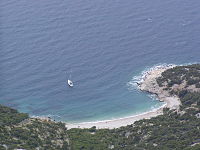Island Cres
Cres (pronounced [t͡srɛ̂ːs] in Croatian; Italian: Cherso, German: Kersch, Latin: Crepsa, Greek: Χερσος, Chersos) is an Adriatic island in Croatia. It is one of the northern island in the Kvarner Gulf and can be reached via ferry from the island Krk or from the Istrian peninsula (line Brestova–Porozina).With an area of 405.78 km²[1], Cres is the same size as the neighbouring island of Krk, although Krk has for many years been thought the largest of the islands. Cres has a population of 3,184 (2001).Cres and the neighbouring island of Lošinj once used to be one island, but were divided by a channel and connected with a bridge at the town of Osor. Cres's only fresh water source is the Lake Vrana.
History
Cres has been inhabited since the Paleolithic time period and was later ruled by the Greeks and the Roman Empire. After the fall of the Roman Empire the island was taken over and became a part of the Byzantine Empire, and remained this way for centuries. In the 7th Century the Croats invaded the island, and the other islands around it, and took the islands over, however the Croats returned the islands in the early 9th century (believed to be somewhere around 812).Around 822 Croatia became an independent state, while on the island Croat-Roman tensions grew. Then, around 866 the inhabitants saw the first conflicts between the Croats and the Republic of Venice. The Venetians eventually set up their rule of the islands in the 10th and 11th centuries.However the Croats regained the islands and the islands went through a change of rulers for centuries, being ruled by Croats, Hungarians, and for 400 years the Venetians took control of the islands. After Napoleon's victory over the Venetians, the island went under Austrian rule. After the defeat of Austria by Napoleon in 1809 the islands became part of the French Empire.After the fall of Napoleon, Austria once again took control of the island for 100 years. During this time the economy developed with olive trees, sage, and other plants becoming key to the success of the island. At the end of World War I, with the Treaty of Rapallo signed in 1920, the island was once again handed over to Italy. This lasted until 1947 when the Islands, along with Istrian Peninsula, were assigned to Yugoslavia.The island has gone through an agricultural downturn as many residents left the island in search of a better life on the mainland and abroad. This has resulted in many former agricultural areas becoming overgrown with local vegetation. Recently people, primarily retirees, have been returning to live on the island. Tourism has become an increasingly important industry and the population experiences significant seasonal variation.
Towns of Cres
The island has many towns, all of them connected by a road that runs down the middle of the island. On one side is the ferry from the mainland (around the city of Pula); on the other is the bridge to Lošinj (Lussino), which was once linked the two but is now separated by a waterway. Approaching the island from Pula, you will first come to Porozina.
A list of the towns with descriptions is below:
- Porozina – A small town comprising the ferry terminal and a few shops.
- Beli – This small town, at the end of a long and very narrow road, is home to a famed bird species, the endangered Griffon vulture.
- Cres
- Orlec – Another small town at the end of a narrow road, also home to the endangered vulture.
- Valun – Visible on the way to Lubenice (see below), this town does not permit cars. A fee is charged for parking.
- Lubenice – An ancient mountain village with a great view of the sea and neighboring islands. A restaurant and bar operate during the warmer months. Weekly musical concerts take place during the peak tourist season.
- Belej
- Stivan – On a side street this small town of 16 people is features a very private beach, old houses and a church, and is on the way to many other towns.
- Merag -with ferry connections
- Miholašćica – A small town with a small church which shares the same name as the community (St. Michael). Tourism has grown here since the arrival of the Zaglav community nearby.
- Martinšćica – The home of a large vacation complex, Slatina, along with beaches and cafes.
- Osor (it. Ossero)- A town on the “border” between two islands. Founded by the Romans who also dug the channel thus dividing what was then known as the Osor island into Cres and Lošinj. Then a major port and commercial centre started to fade with coming of larger ships that could not pass the narrow channel or dock in the shallow port.
- Pernat – The westernmost village on Cape Pernat. A quaint and rustic village forming a gateway to numerous walking trails and secluded beaches.
- Podol – Between Lubenice and Valun. A tiny hamlet that resembles a large farmhouse. Its key feature is the mulberry tree located in the middle of the road.
- Punta Kriza – The southernmost part of Cres. FKK resort is here.
- Vidovici – A short distance uphill from Martinšćica. A village with an extraordinary view of the Istrian Peninsula and numerous islands including Zeča, Lošinj and Unije forming part of the archipelago. A restaurant operates in the evenings during the warmer months.
The Town of Cres
The town of Cres has many shops where tourists can buy local specialties such as homemade olive oil and wine. The town is not made for cars, it is a walking city with narrow streets. Cres also has a marina nearby, which has been awarded the blue flag status, with many boats in it.
Construction and Improvements
A massive work effort is taking place on the main road, it is being widened and is being brought further away from the cliffs, the road is also cutting out dangerous turns and other threats to drivers. It is also keeping trucks and cars away from Lake Vrana, to keep it clean. As of July 2007, the work is about 30-40% complete. The work is being done by the construction company GP Krk.
Lake Vrana
Cres has its very own fresh water lake, which is very highly guarded and illegal to swim and fish in. It supplies water to neighboring Lošinj (it. Lussino) as well. It is one of the deepest fresh water lakes in Eastern Europe, going down 76 meters at its deepest point (>50 m below sea-level).[2]
Myth of Lake Vrana
There is a local legend that there is a castle under the lake. According to the legend, a rich sister who lived in the castle would not give her much poorer sister money or food. As a result she was punished by having her castle flooded during a severe thunderstorm which caused Lake Vrana to be created. The story goes on to tell that on some windy days, if one is to listen very carefully the tower bells can still be heard ringing to this day. Source: Wikipedia




